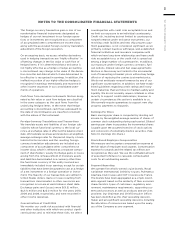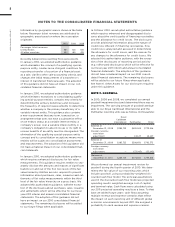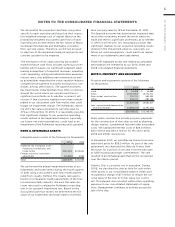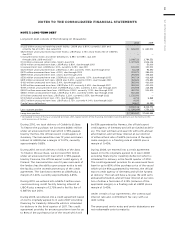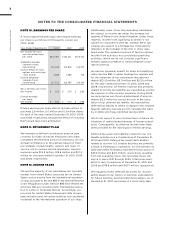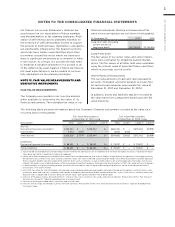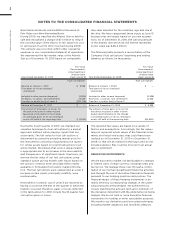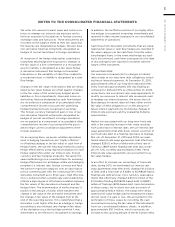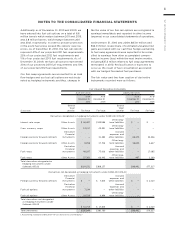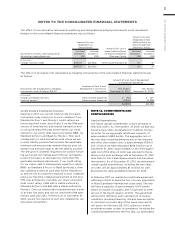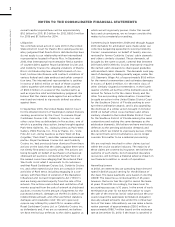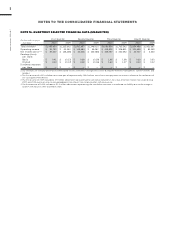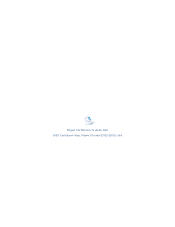Royal Caribbean Cruise Lines 2010 Annual Report Download - page 82
Download and view the complete annual report
Please find page 82 of the 2010 Royal Caribbean Cruise Lines annual report below. You can navigate through the pages in the report by either clicking on the pages listed below, or by using the keyword search tool below to find specific information within the annual report.
NOTES TO THE CONSOLIDATED FINANCIAL STATEMENTS
ROYAL CARIBBEAN CRUISES LTD. 79
We enter into various forward, swap and option con-
tracts to manage our interest rate exposure and to
limit our exposure to fluctuations in foreign currency
exchange rates and fuel prices. These instruments are
recorded on the balance sheet at their fair value and
the majority are designated as hedges. We also have
non-derivative financial instruments designated as
hedges of our net investment in foreign operations.
At inception of the hedge relationship, a derivative
instrument that hedges the exposure to changes in
the fair value of a firm commitment or a recognized
asset or liability is designated as a fair value hedge.
A derivative instrument that hedges a forecasted
transaction or the variability of cash flows related to
a recognized asset or liability is designated as a cash
flow hedge.
Changes in the fair value of derivatives that are desig-
nated as fair value hedges are offset against changes
in the fair value of the underlying hedged assets,
liabilities or firm commitments. Gains and losses on
derivatives that are designated as cash flow hedges
are recorded as a component of accumulated other
comprehensive income (loss) until the underlying
hedged transactions are recognized in earnings.
The foreign-currency transaction gain or loss of our
non-derivative financial instruments designated as
hedges of our net investment in foreign operations
are recognized as a component of accumulated other
comprehensive income (loss) along with the associ-
ated foreign currency translation adjustment of the
foreign operation.
On an ongoing basis, we assess whether derivatives
used in hedging transactions are “highly effective”
in offsetting changes in the fair value or cash flow of
hedged items. We use the long-haul method to assess
hedge effectiveness using regression analysis for each
hedge relationship under our interest rate, foreign
currency and fuel hedging programs. We apply the
same methodology on a consistent basis for assessing
hedge effectiveness to all hedges within each hedging
program (i.e. interest rate, foreign currency and fuel).
We perform regression analyses over an observation
period commensurate with the contractual life of the
derivative instrument up to three years. High effective-
ness is achieved when a statistically valid relationship
reflects a high degree of offset and correlation between
the fair values of the derivative instrument and the
hedged item. The determination of ineffectiveness is
based on the amount of dollar offset between the
change in fair value of the derivative instrument and
the change in fair value of the hedged item at the
end of the reporting period. If it is determined that a
derivative is not highly effective as a hedge or hedge
accounting is discontinued, any change in fair value
of the derivative since the last date at which it was
determined to be effective is recognized in earnings.
In addition, the ineffective portion of our highly effec-
tive hedges is recognized in earnings immediately and
reported in other income (expense) in our consolidated
statements of operations.
Cash flows from derivative instruments that are desig-
nated as fair value or cash flow hedges are classified in
the same category as the cash flows from the under-
lying hedged items. In the event that hedge account-
ing is discontinued, cash flows subsequent to the date
of discontinuance are classified consistent with the
nature of the instrument.
Interest Rate Risk
Our exposure to market risk for changes in interest
rates relates to our long-term debt obligations includ-
ing future interest payments. At December 31, 2010,
approximately 49% of our long-term debt was effec-
tively fixed and approximately 51% was floating as
compared to 43% and 57% as of December 31, 2009,
respectively. We use interest rate swap agreements to
modify our exposure to interest rate movements and
to manage our interest expense. We assess the risk
that changes in interest rates will have either on the
fair value of debt obligations or on the amount of
future interest payments by monitoring changes in
interest rate exposures and by evaluating hedging
opportunities.
Market risk associated with our long-term fixed rate
debt is the potential increase in fair value resulting
from a decrease in interest rates. We use interest rate
swap agreements that effectively convert a portion of
our fixed-rate debt to a floating-rate basis to manage
this risk. At December 31, 2010 and 2009, we main-
tained interest rate swap agreements that effectively
changed $350.0 million of debt with a fixed rate of
7.25% to LIBOR-based floating rate debt plus a mar-
gin of 1.72%, currently approximately 2.18%. These
interest rate swap agreements are accounted for as
fair value hedges.
In an effort to increase our percentage of fixed rate
debt, during 2010, we terminated our interest rate
swap agreements that effectively changed €1.0 billion
of debt with a fixed rate of 5.625% to EURIBOR-based
floating rate debt and our cross currency swap agree-
ments that effectively changed €300.0 million of the
€1.0 billion floating EURIBOR-based debt to $389.1
million of floating LIBOR-based debt. Upon termination
of these swaps, we received net cash proceeds of
approximately $115.4 million. The swaps were desig-
nated as fair value hedges and terminating the swaps
did not result in a gain or loss. We accounted for the
termination of these swaps by recording the cash
received and removing the fair value of the instruments
from our consolidated balance sheets. In addition,
approximately $91.1 million, which represents an
increase to the carrying amount of the €1.0 billion debt,


